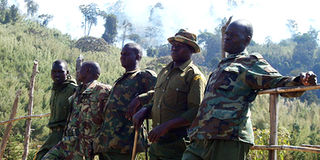Alarm as fires destroy Mau

Kenya Wildlife Service rangers stand guard on the edge of Mau Forest in Njoro District on Sunday as smoke billows from the burning forest in the background. Photo/NOAH CHEPLOEN
What you need to know:
- Infernos started by people who want to derail plans to save resource, say villagers
Efforts to give the endangered Mau Forest a new lease of life suffered another setback when wildfires suspected to have been started by arsonists destroyed more than 200 hectares of the natural resource.
On Sunday, villagers made frantic efforts to put out the fires that started on Saturday. But their attempts were hampered by strong winds blowing across the hilly forest and lack of equipment.
At a public baraza called by Njoro district commissioner Jim Njoka, the villagers said they have been fighting pockets of fires in the forest in the past weeks. They claimed the fires had been started by people who wanted to derail the conservation of the forest.
Affected most
Logman and Neisuit forests, covering a total of 8,000 hectares in the Mau Complex, were affected most by the fires. Less than 20 rangers are keeping vigil in the two forests.
Mau Forest is the biggest water catchment area in the country and its destruction has drawn condemnation locally and abroad.
Prime Minister Raila Odinga says those who have encroached would be evicted.
A taskforce formed to provide the way forward for the government is expected to present its report soon.
“If it means removing you, then we will do that,” Mr Njoka said.
“We treasure this forest and we have been protecting it from loggers and those who want to destroy it by setting it on fire,” said Mr Daniel Bor, a villager who blamed ethnic hatred for the latest destruction of the natural resource.
“There is a group which has been claiming that this is their ancestral land and are angry that our people were allocated plots here by the government. They are now trying every trick to ensure that we are removed,” the villager told Mr Njoka.
The forest is inhabited by members of the Kipsigis and Ogiek communities.
Mr Njoka said the impact of the destruction was already visible, with rivers that are a source of water to the thousands of people in Nakuru, Narok, Baringo Njoro and Molo drying up.
Uncontrollable
Kenya Forestry Service and Kenya Wildlife Service officials and residents were by Saturday evening battling fierce wild fires that destroyed several hectares at the Abardares National Park and the Marmanet.
The games warden in charge of the Northern Abardares, Mr Simon Wachiuri, said a lot of the forest cover had been destroyed, adding that the fires had become uncontrollable due to the dry weather and strong winds.
Hundreds of wild animals within the area, he said, had fled to safer zones, but added that some of the animals could have been killed by the blaze.
Mr Wachiuri called on the locals to be cautious when handling fires, saying the dry spell was dangerous to the ecosystem and biodiversity of the region because it made it susceptible to wildfires




